The Marshall Star for October 11, 2023

NASA/Mick Speer
Marshall Presents Small Business Awards for 2023
NASA’s Marshall Space Flight Center honored top contractors, subcontractors, teams, and individuals of fiscal year 2023 at the 36th meeting of the Marshall Small Business Alliance.
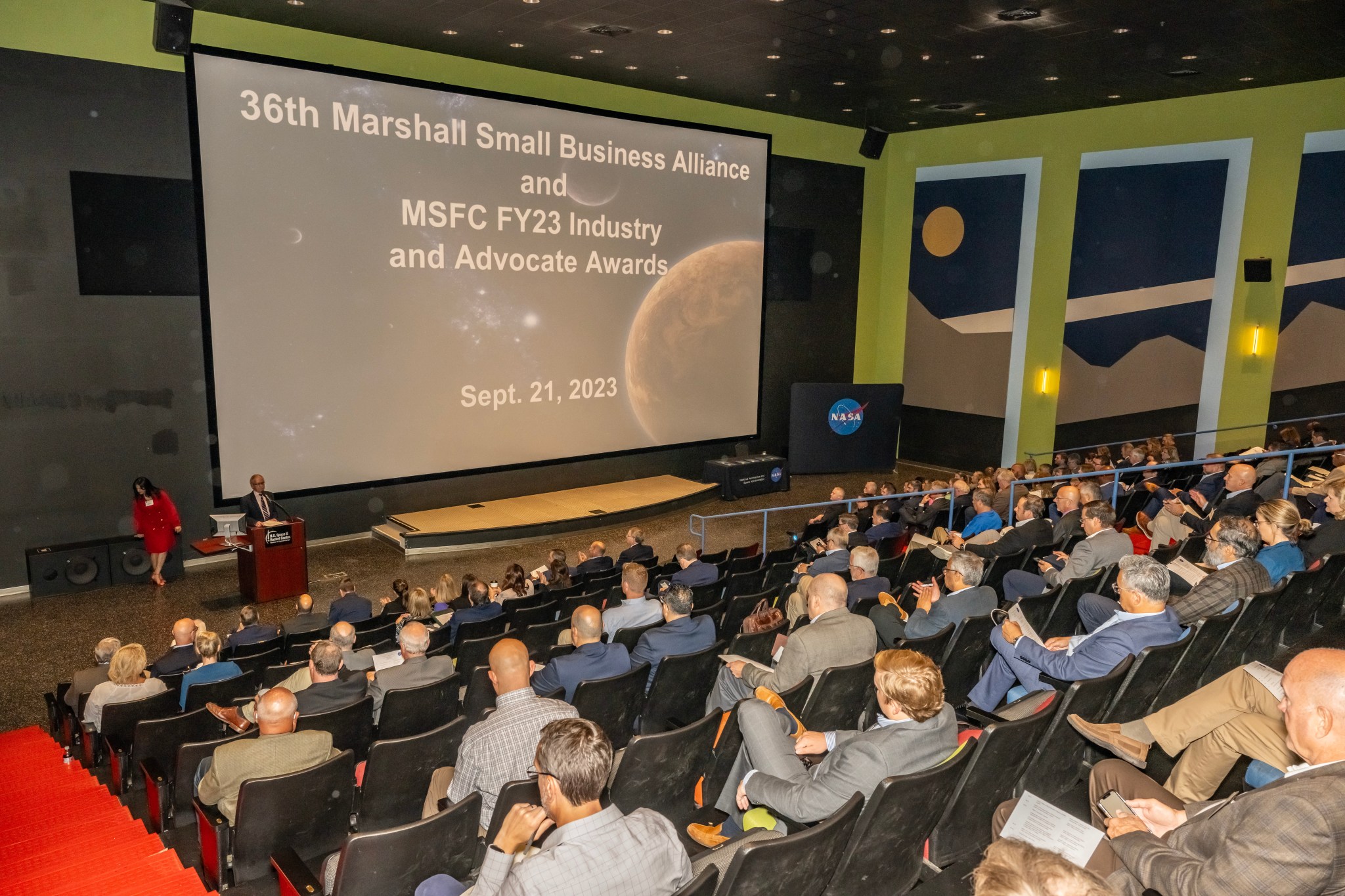
The event took place Sept. 21 at the U.S. Space & Rocket Center’s Davidson Center for Space Exploration. Around 600 participants from industry and government gathered to network, learn about business opportunities, and recognize outstanding achievements in support of NASA’s mission and the small business community.
“Marshall is an engine of opportunity for its community and beyond,” said David Brock, small business specialist in Marshall’s Office of Procurement.

Marshall’s Industry & Advocate Awards are presented annually and reflect leadership in business community and sustained achievement in service to NASA’s mission.
This year’s award recipients are:
Small Business Prime Contractor of the Year
Victory Solutions Inc.
Small Business Subcontractor of the Year
Waterfront Technical Services
Large Business Prime Contractor of the Year
Jacobs Space Exploration Group
Small Business Mentor-Protégé of the Year Award
Jacobs/CH2M and K.S. Ware
Procurement Person of the Year
Dana Justice, Marshall Office of Procurement
Program Team of the Year
2023 Small Business Action Team, Marshall Office of Procurement
Michelle Anzalone, Ashley Cox, Stephanie Darnell, John David Eagan, Dana Justice, and Josh Wilbourn
Small Business Technical Advisor of the Year
Chip Jones, Marshall Science & Technology Office
Small Business Technical Person of the Year
Karen Lawler, Marshall Office of the Chief Financial Officer
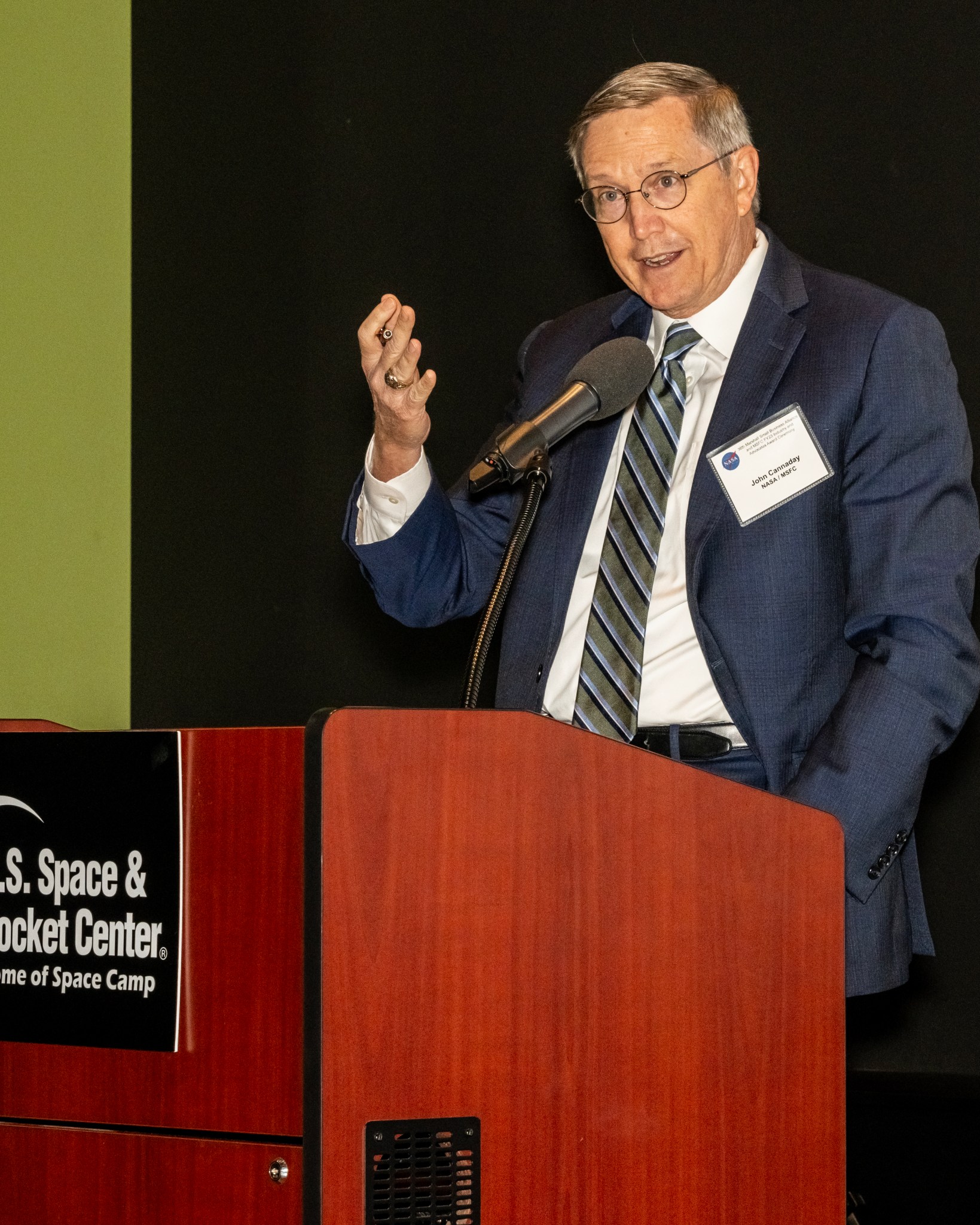
NASA civil service employees nominate eligible individuals and organizations for awards. A panel of NASA procurement and technical officials evaluates each nominee’s business practices, innovative processes, adoption of new technologies and their overall contributions to NASA’s mission and the agency’s Small Business Program.
Award recipients in the following categories become candidates for agency-level Small Business Industry and Advocate Awards:
- Large and Small Business Prime Contractors of the Year
- Small Business Subcontractor of the Year
- Procurement Team or Person
- Technical, Small Business Technical Coordinator/Technical Advisor
- Program Person or Team of the Year
Learn more about Marshall’s small business initiatives.
NASA Announces Teams for 2024 Student Launch Challenge
NASA has announced the 70 teams representing 24 states and Puerto Rico selected to compete in the 2024 Student Launch Challenge.
The annual competition – one of NASA’s nine Artemis Student Challenges – requires middle/high school and college/university students to design, build, and fly a high-powered amateur rocket and scientific payload.
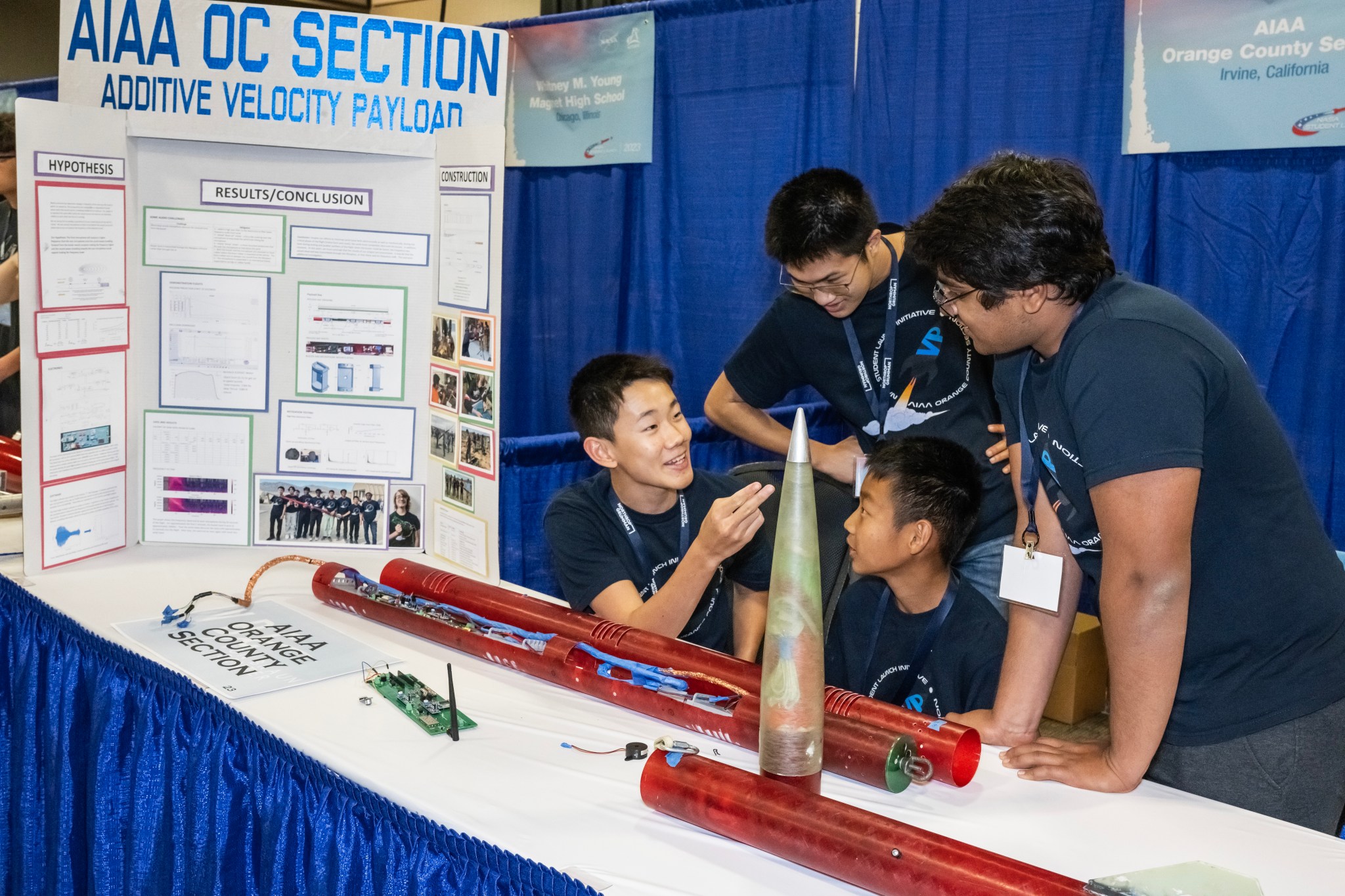
The nine-month-long challenge will culminate with on-site events April 10-14, 2024, with final launches April 13 at Bragg Farms in Toney, Alabama, just minutes north of NASA’s Marshall Space Flight Center. Teams are not required to travel for their final launch, having the option to launch from a qualified. Details are outlined in the Student Launch Handbook.
Each year NASA implements a new payload challenge to reflect relevant missions. This year’s payload challenge is inspired by the Artemis missions, which seek to land the first woman and first person of color on the Moon.
Students will design a SAIL (STEMnaut Atmosphere Independent Lander) payload. It must deploy mid-air, safely return to the ground without using a parachute, and be reusable to launch the same day without repairs or modifications. The payload will contain a crew of four STEMnauts, non-living objects representing astronauts. Students will choose metrics to determine the endurance of the lander, considering acceptable descent and landing parameters.
University/college teams are required to meet the 2024 payload requirements set by NASA, but middle/high school teams have the option to tackle the same challenge or design their own payload experiment.
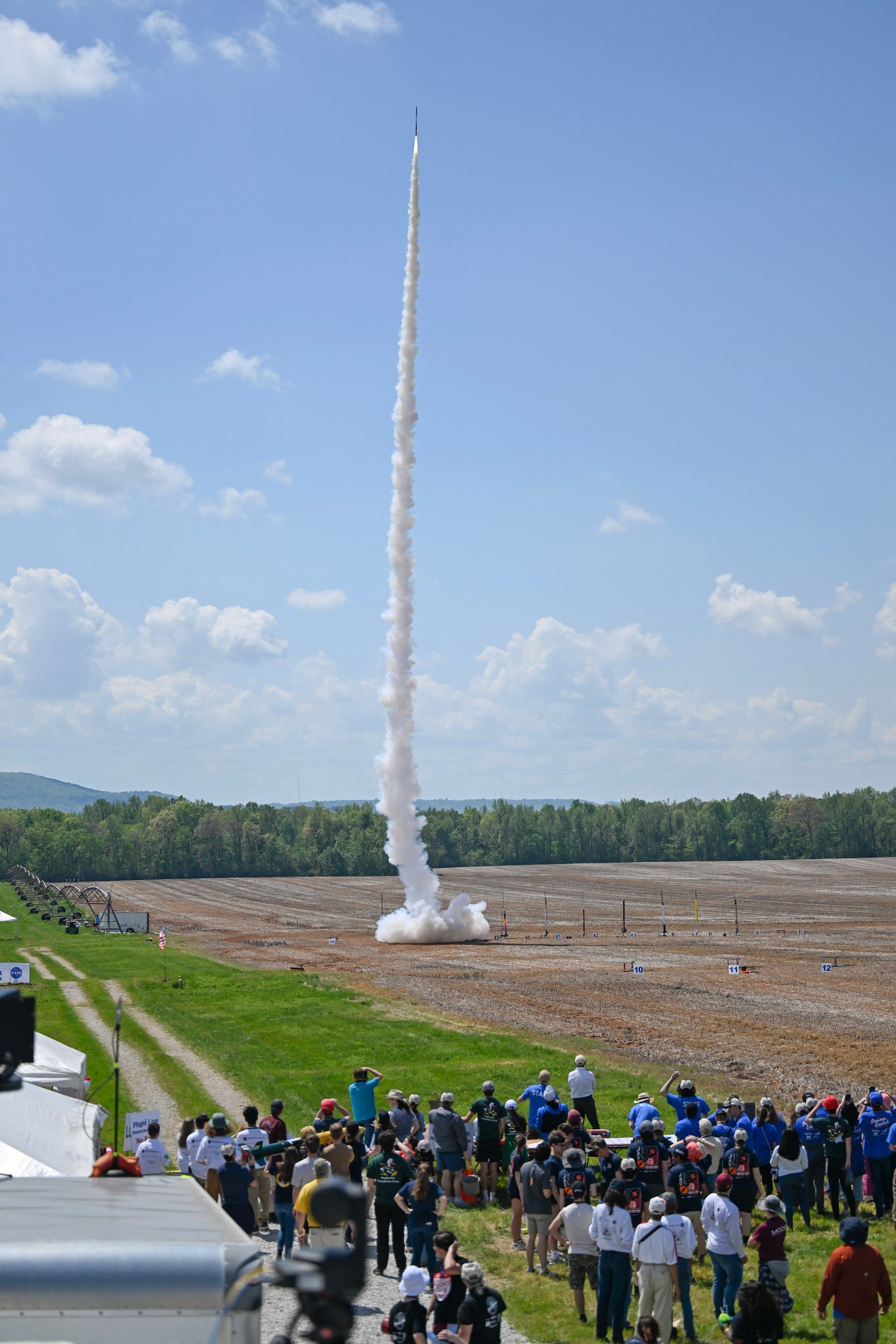
Student teams will undergo detailed reviews by NASA personnel to ensure the safety and feasibility of their rocket and payload designs. All teams must declare their rocket’s targeted altitude for final launch day during a preliminary design review. The team closest to their target will win the Altitude Award, just one of multiple awards presented to deserving teams at the end of the competition. Other awards include overall winner, vehicle design, experiment design, social media presence, and more.
In addition to the engineering and science side of the competition, students must also participate in outreach efforts such as engaging with local schools and maintaining effective social media accounts. Student Launch is an all-encompassing challenge and aims to prepare the next generation for the professional world of space exploration.
The competition is managed by Marshall’s Office of STEM Engagement (OSTEM). Additional funding and support are provided by NASA’s OSTEM via the Next Gen STEM project, NASA’s Space Operations Mission Directorate, Northrup Grumman, National Space Club Huntsville, American Institute of Aeronautics and Astronautics, National Association of Rocketry, Relativity Space, and Bastion Technologies.
Racers Run, Bike, Run to Beat the Space Station in Annual Duathlon
On the morning of Sept. 30, 160 athletes ran and biked across NASA’s Marshall Space Flight Center and Redstone Arsenal in a race to beat the International Space Station. The annual “Racin’ the Station” duathlon is a run-bike-run event where participants try to complete the course faster than it takes the space station to complete one Earth orbit, which is every 91 minutes, 12 seconds.
Organizers track the starting location of the space station at the race start, and a costumed pacer keeps up with the station time on the course as a visual marker for participants to stay ahead of. Before the race, organizers drew a to-scale Space Launch System Block 1 rocket in chalk onto the Activities Building parking lot near the race transition area. The race began in 2012, and this year was the 11th running (the event did not occur in 2020 due to the pandemic).
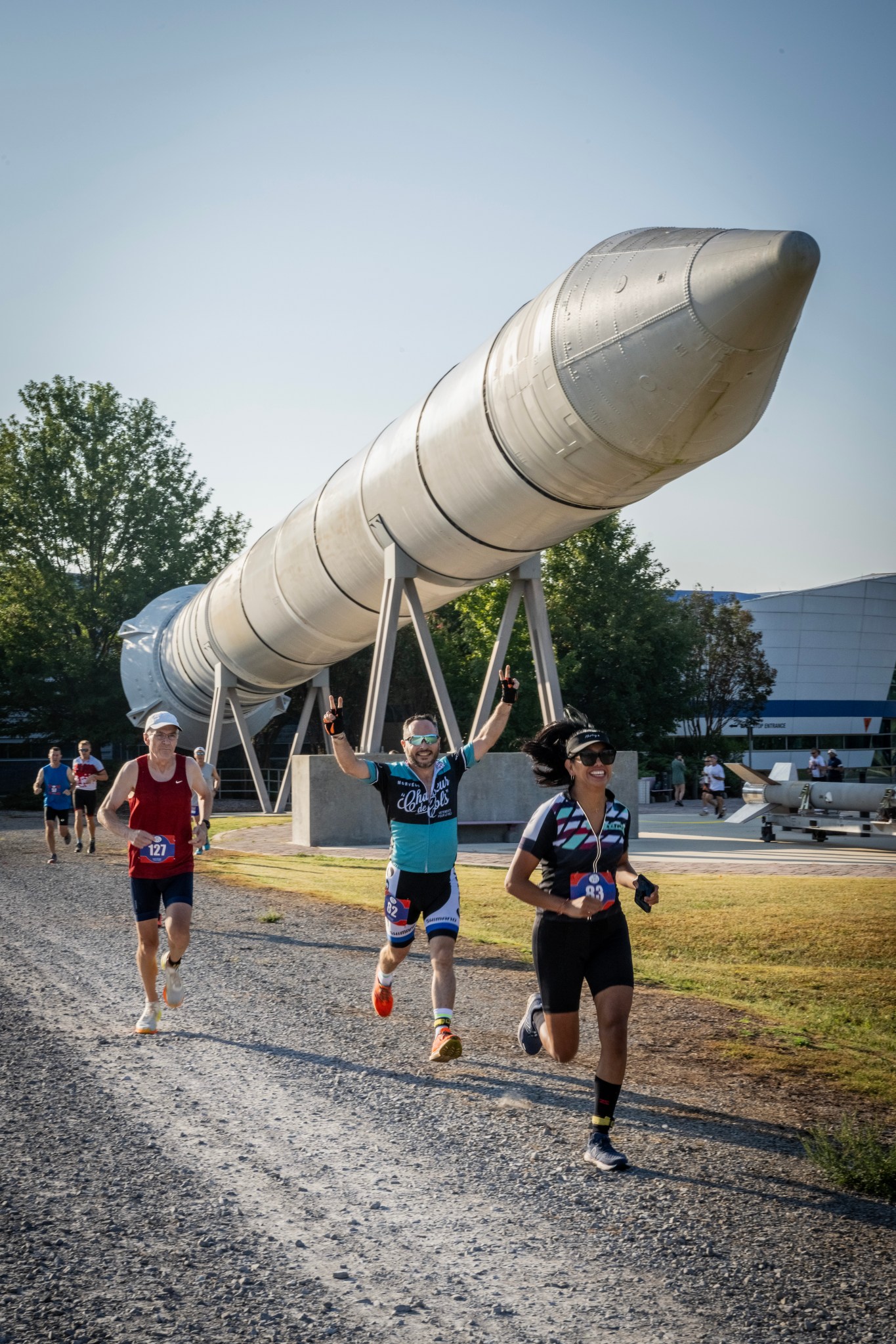
“Racin’ the Station” is not just an athletic event,” said race director and Marshall engineer Kent Criswell. “I try to also focus on educating the community about what Marshall is doing. For example, the water aid station on the run course – I call it the ECLSS (Environmental Control and Life Support System) station, but I also assure them that the water is not recycled urine from astronauts! It is a great event for any geek in the southeast — people drive all the way from Birmingham and Nashville to compete.”
The event began at 7:50 a.m. with an opening ceremony in Marshall’s Activities Building, where racers got pumped up watching the Metallica/NASA “Fuel” video for Artemis II. With the weather slowly warming, the field took off at 8:15 a.m., with a model rocket launch as the starting signal. The “station pacer” this year was dressed as Star-Lord, a superhero character appearing in the comic book and film series “Guardians of the Galaxy.”

The course is three legs: a 3.14 km run, followed by a 23 km bicycle ride, and another 3.14 km run, with the start and finish line at Marshall’s Wellness Center. Race organizers arranged the distances to coincide with the number pi, approximately 3.14.
Participants can complete the entire race as an individual, or as a relay team. Eighteen teams and 124 individual racers competed, and 92 of those beat the station this year.

The event is organized by the Team Rocket Triathlon Club in Huntsville and by the Marshall Association, a professional employee service organization at the Marshall Center whose members include civil service employees, retirees, and contractors.
For details on the race, including course maps and distances, visit the Racin’ the Station Duathlon website. Race results can be found here.
Psyche Mission Highlighted on ‘This Week at NASA’
NASA is targeting no earlier than Oct. 12 for the launch of its Psyche spacecraft on a 2.2-billion-mile journey to study a metal-rich asteroid of the same name. The mission is featured in “This Week @ NASA,” a weekly video program broadcast on NASA-TV and posted online.
The Psyche asteroid lies in the outer portion of the main asteroid belt between Mars and Jupiter, and may be able to tell us more about the formation of rocky planets like Earth. This is NASA’s first mission to study an asteroid that has more metal than rock or ice.
Watch live coverage of the Oct. 12 Psyche launch beginning at 8:30 a.m. on NASA TV.
Psyche is the 14th planetary exploration mission in NASA’s Discovery program, which is managed for the agency by NASA’s Marshall Space Flight Center. Read more about Marshall’s role in the Psyche mission.
View this and previous episodes at “This Week @NASA” on NASA’s YouTube page.
Experience Solar Eclipse on Oct. 14
On Oct. 14, 2023, and April 8, 2024, the entire United States and millions around the world will be able to view a solar eclipse.
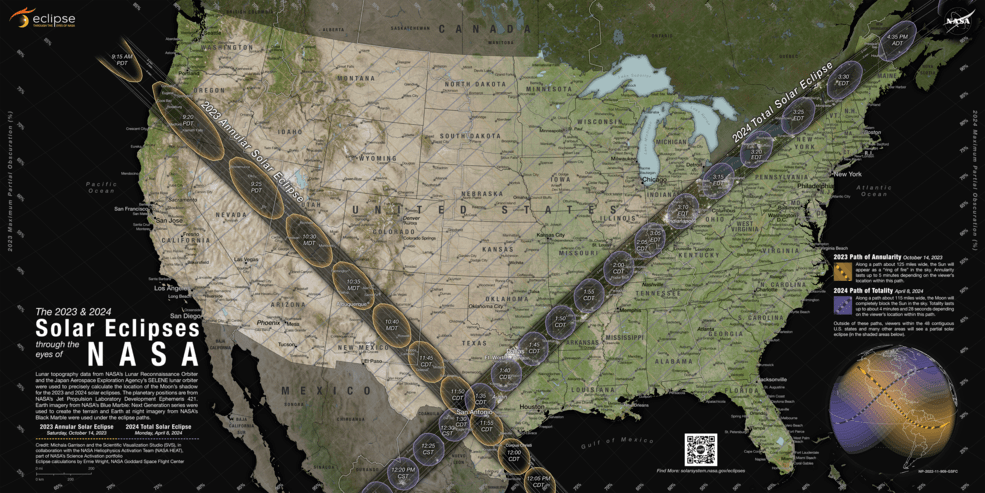
There are three different kinds of solar eclipses: total, annular, and partial. When the Moon is far from the Earth, its size is too small to completely cover the Sun, thus an annular eclipse is observed, like what is expected on Oct. 14. When the Moon is close to the Earth, its larger size completely covers the Sun, causing a total eclipse, which will occur on April 8, 2024. A partial eclipse occurs when the Earth, Moon, and Sun are not perfectly aligned so only a part of the Sun will appear to be covered, giving it a crescent shape. During a total or annular solar eclipse, people outside the totality/annularity paths will see a partial solar eclipse.

Mitzi Adams, NASA Marshall Space Flight Center Heliophysics and Planetary Science branch assistant chief, shares her observations during the five total eclipses she has experienced. “It is like nothing you’ve ever experienced before. It’s sort of like somebody puts a bowl on top of Earth right above where you’re standing. In the middle of the day, it gets darker, but you can still see light around the rim.” Adams explains. “You can essentially observe a sunrise or sunset. The temperatures cool. The wind picks up. The birds may go to roost, or the coyotes may howl.”
During an annular eclipse like the one coming up on Oct. 14, even with the sun covered up to 90%, the sky remains fairly bright. Those in the path of annularity will have a chance to observe the famed “ring of fire” effect, but it is important to manage your expectations and to remember that solar viewing glasses will be needed during the event’s entirety.
Bill Cooke, NASA’s Meteoroid Environment Office lead and eclipse enthusiast, says he is most looking forward to the 2024 total eclipse because totality, when the sun is covered 100%, will last much longer than the last total eclipse in 2017 – up to nearly four and a half minutes.
In any of the upcoming eclipse events, in our technology-fueled world, you may also experience some electronic changes as the moon moves across Earth and the ionosphere cools.
The ionosphere forms the boundary between the Earth’s lower atmosphere – where we live and breathe – and the vacuum of space. It is formed when particles are charged, or ionized, by solar radiation. A total solar eclipse effectively “turns off” the ionosphere’s primary charging mechanism, mimicking nighttime conditions, so the many communications signals passing through the ionosphere could be disrupted.
GPS signals could produce location errors. Radio waves could change, sometimes even allowing Ham Radio operators to send or receive transmissions over longer distances.
The ionosphere is also home to many NASA satellites, including the International Space Station.
Experiencing an eclipse is one way that everyone can participate in NASA Science. Depending on your access to different types of technology (phones, laptops, telescopes), there are several NASA Citizen Science projects you can participate in that relate to the Sun’s corona and the effects of the Moon’s shadow on Earth’s upper atmosphere.
- GLOBE Observer
- Help monitor the conditions of clouds, water (especially as a habitat for mosquitoes), plants (trees and other land cover), and see change over time.
- Solar Jet Hunter
- Join the hunt for solar jets – enigmatic bursts of energy from our own star – the Sun.
- Planet Hunters Transiting Exoplanet Survey Satellite (TESS)
- Find planets that will help us understand how these extrasolar systems form and evolve over time
- Eclipse Soundscapes
- Provide multi-sensory observations and recorded sound data to study how solar eclipses affect life on Earth!
- HamSCI
- Advance scientific research and understanding through amateur radio activities.
- Radio JOVE
- Observe and analyze natural radio emissions of Jupiter, the Sun, and our galaxy using their own easy to construct radio telescopes.
- Sungrazer Project
- Become a “Comet Hunter”, and immediately begin looking for new comets in the spacecraft data.
Regardless of how you plan to experience a solar eclipse, or any solar viewing for that matter, remember to always do so safely.
NASA’s Bennu Asteroid Sample Contains Carbon, Water
Initial studies of the 4.5-billion-year-old asteroid Bennu sample collected in space and brought to Earth by NASA show evidence of high-carbon content and water, which together could indicate the building blocks of life on Earth may be found in the rock. NASA made the news Oct. 11 from its Johnson Space Center where leadership and scientists showed off the asteroid material for the first time since it landed in September.
This finding was part of a preliminary assessment of NASA’s OSIRIS-REx (Origins, Spectral Interpretation, Resource Identification and Security – Regolith Explorer) science team.
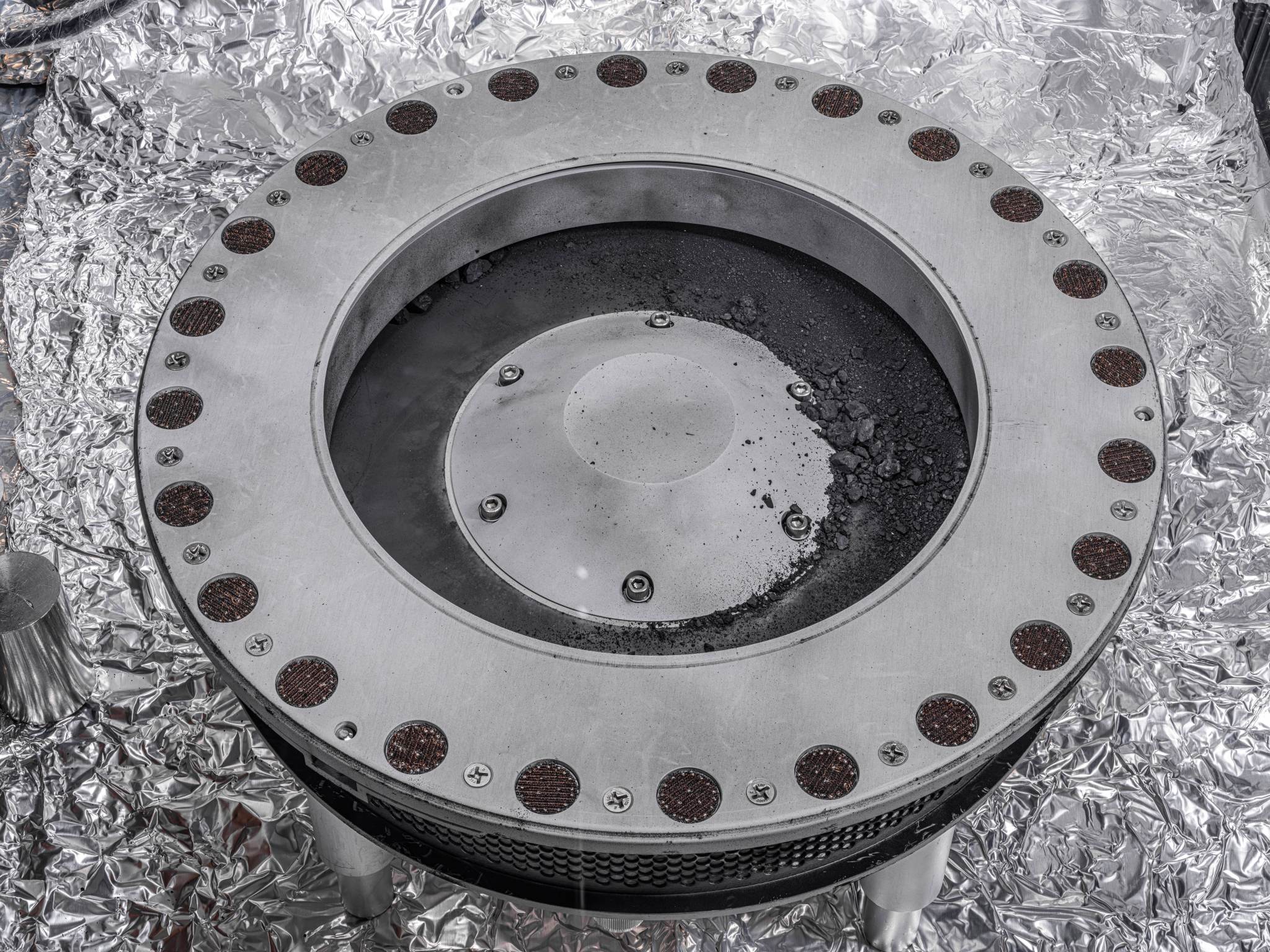
“The OSIRIS-REx sample is the biggest carbon-rich asteroid sample ever delivered to Earth and will help scientists investigate the origins of life on our own planet for generations to come,” said NASA Administrator Bill Nelson. “Almost everything we do at NASA seeks to answer questions about who we are and where we come from. NASA missions like OSIRIS-REx will improve our understanding of asteroids that could threaten Earth while giving us a glimpse into what lies beyond. The sample has made it back to Earth, but there is still so much science to come – science like we’ve never seen before.”
Although more work is needed to understand the nature of the carbon compounds found, the initial discovery bodes well for future analyses of the asteroid sample. The secrets held within the rocks and dust from the asteroid will be studied for decades to come, offering insights into how our solar system was formed, how the precursor materials to life may have been seeded on Earth, and what precautions need to be taken to avoid asteroid collisions with our home planet.
The goal of the OSIRIS-REx sample collection was 60 grams of asteroid material. Curation experts at NASA Johnson, working in new clean rooms built especially for the mission, have spent 10 days so far carefully disassembling the sample return hardware to obtain a glimpse at the bulk sample within. When the science canister lid was first opened, scientists discovered bonus asteroid material covering the outside of the collector head, canister lid, and base. There was so much extra material it slowed down the careful process of collecting and containing the primary sample.
“Our labs were ready for whatever Bennu had in store for us,” said Vanessa Wyche, director, NASA Johnson. “We’ve had scientists and engineers working side-by-side for years to develop specialized gloveboxes and tools to keep the asteroid material pristine and to curate the samples so researchers now and decades from now can study this precious gift from the cosmos.”
Within the first two weeks, scientists performed “quick-look” analyses of that initial material, collecting images from a scanning electron microscope, infrared measurements, X-ray diffraction, and chemical element analysis. X-ray computed tomography was also used to produce a 3D computer model of one of the particles, highlighting its diverse interior. This early glimpse provided the evidence of abundant carbon and water in the sample.
“As we peer into the ancient secrets preserved within the dust and rocks of asteroid Bennu, we are unlocking a time capsule that offers us profound insights into the origins of our solar system,” said Dante Lauretta, OSIRIS-REx principal investigator, University of Arizona, Tucson. “The bounty of carbon-rich material and the abundant presence of water-bearing clay minerals are just the tip of the cosmic iceberg. These discoveries, made possible through years of dedicated collaboration and cutting-edge science, propel us on a journey to understand not only our celestial neighborhood but also the potential for life’s beginnings. With each revelation from Bennu, we draw closer to unraveling the mysteries of our cosmic heritage.”
For the next two years, the mission’s science team will continue characterizing the samples and conduct the analysis needed to meet the mission’s science goals. NASA will preserve at least 70% of the sample at Johnson for further research by scientists worldwide, including future generations of scientists. As part of OSIRIS-REx’s science program, a cohort of more than 200 scientists around the world will explore the regolith’s properties, including researchers from many U.S. institutions, NASA partners JAXA (Japan Aerospace Exploration Agency), CSA (Canadian Space Agency), and other scientists from around the world. Additional samples will also be loaned later this fall to the Smithsonian Institution, Space Center Houston, and the University of Arizona for public display.
NASA’s Goddard Space Flight Center provides overall mission management, systems engineering, and the safety and mission assurance for OSIRIS-REx. Lauretta, the principal investigator, leads the science team and the mission’s science observation planning and data processing. Lockheed Martin Space in Littleton, Colorado, built the spacecraft, provided flight operations, and was responsible for capsule recovery. Goddard and KinetX Aerospace were responsible for navigating the OSIRIS-REx spacecraft. Curation for OSIRIS-REx, including processing the sample when it arrived on Earth, is taking place at NASA Johnson.
OSIRIS-REx is the third mission in NASA’s New Frontiers Program, managed by NASA’s Marshall Space Flight Center for the Science Mission Directorate at NASA Headquarters. Read more about Marshall’s role in OSIRIS-REx.
Webb Captures an Ethereal View of NGC 346
One of the greatest strengths of NASA’s James Webb Space Telescope is its ability to give astronomers detailed views of areas where new stars are being born. The latest example, showcased in a new image from Webb’s MIRI (Mid-Infrared Instrument), is NGC 346 – the brightest and largest star-forming region in the SMC (Small Magellanic Cloud).
The SMC is a satellite galaxy of the Milky Way, visible to the unaided eye in the southern constellation Tucana. This small companion galaxy is more primeval than the Milky Way in that it possesses fewer heavy elements, which are forged in stars through nuclear fusion and supernova explosions, compared to our own galaxy.
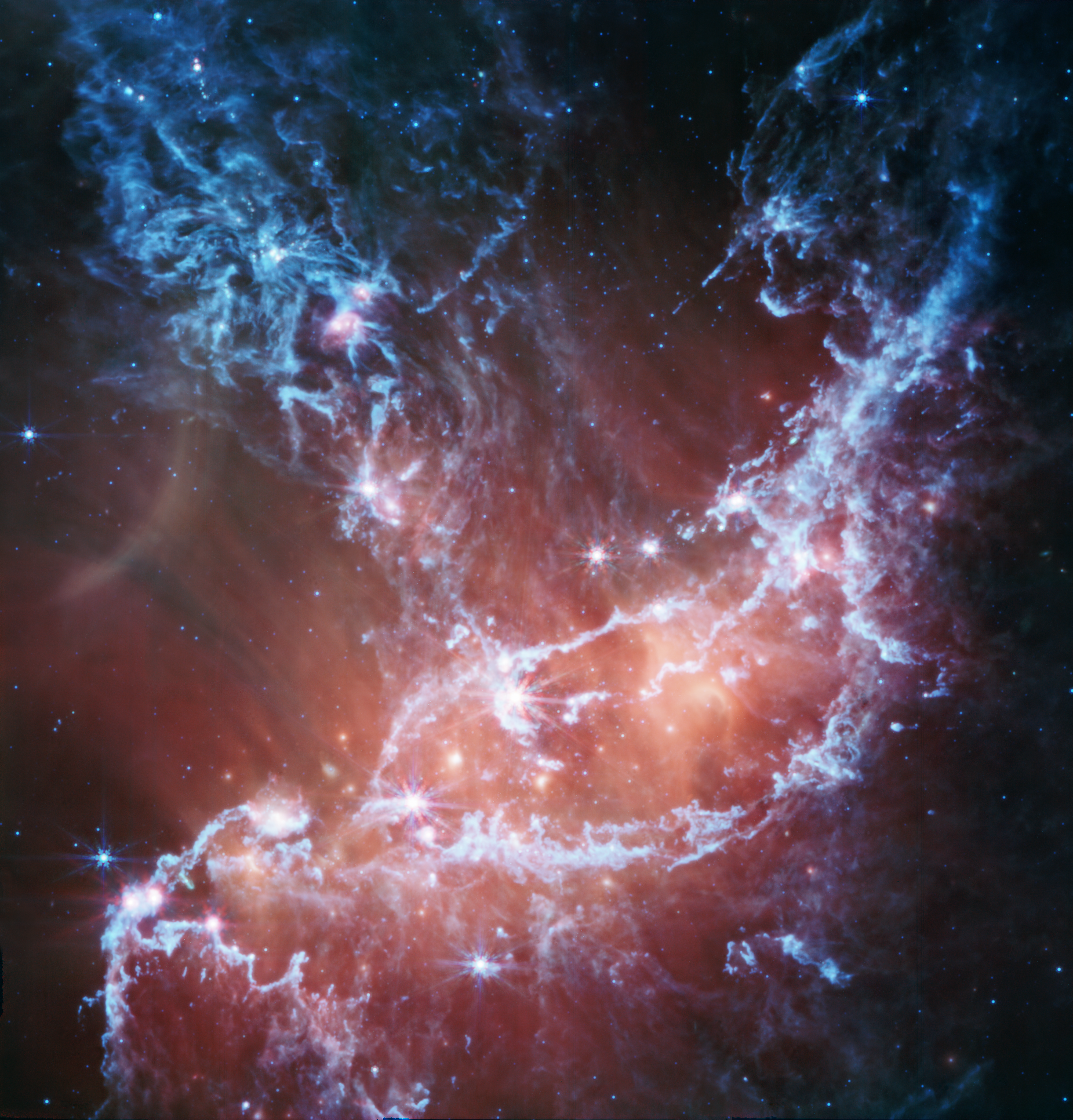
Since cosmic dust is formed from heavy elements like silicon and oxygen, scientists expected the SMC to lack significant amounts of dust. However the new MIRI image, as well as a previous image of NGC 346 from Webb’s Near-Infrared Camera released in January, show ample dust within this region.
In this representative-color image, blue tendrils trace emission from material that includes dusty silicates and sooty chemical molecules known as polycyclic aromatic hydrocarbons, or PAHs. More diffuse red emission shines from warm dust heated by the brightest and most massive stars in the heart of the region. An arc at the center left may be a reflection of light from the star near the arc’s center. (Similar, fainter arcs appear associated with stars at lower left and upper right.) Lastly, bright patches and filaments mark areas with abundant numbers of protostars. The research team looked for the reddest stars, and found 1,001 pinpoint sources of light, most of them young stars still embedded in their dusty cocoons.
By combining Webb data in both the near-infrared and mid-infrared, astronomers are able to take a fuller census of the stars and protostars within this dynamic region. The results have implications for our understanding of galaxies that existed billions of years ago, during an era in the universe known as “cosmic noon,” when star formation was at its peak and heavy element concentrations were lower, as seen in the SMC.
The James Webb Space Telescope is the world’s premier space science observatory. Webb is solving mysteries in our solar system, looking beyond to distant worlds around other stars, and probing the mysterious structures and origins of our universe and our place in it. Webb is an international program led by NASA with its partners, ESA (European Space Agency) and the Canadian Space Agency. Several NASA centers contributed to the project, including NASA’s Marshall Space Flight Center.
Click here for original story, The Marshall Star for October 11, 2023
Source: NASA Earth News